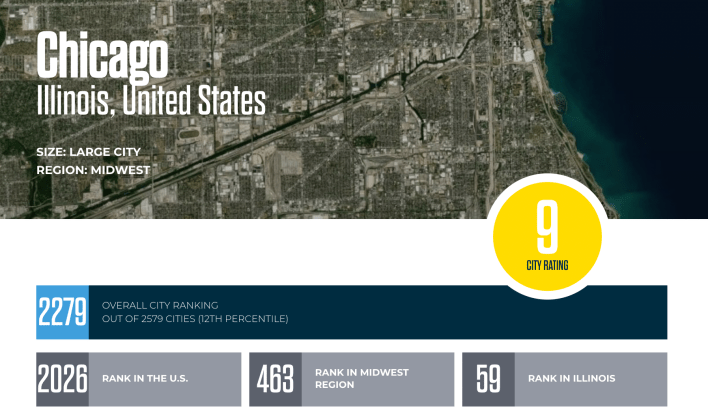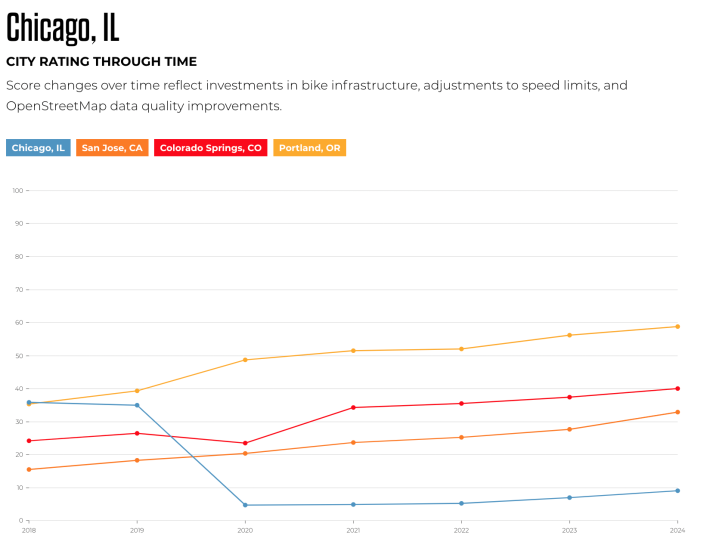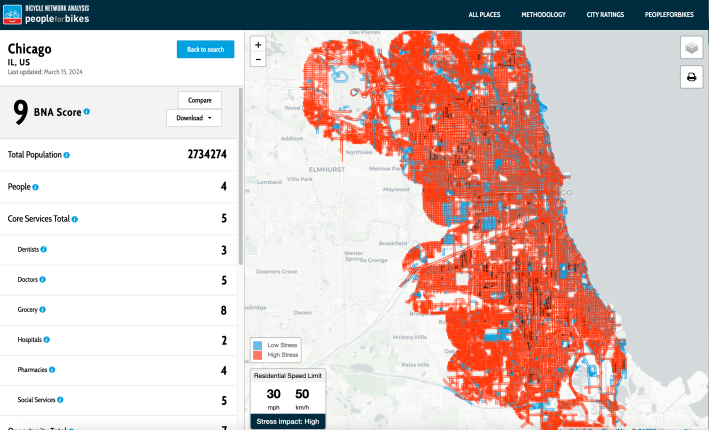
Chicagoans, don't say I didn't warn you.
The Boulder, CO-based advocacy nonprofit People for Bikes annual City Ratings report gave our city unreasonably wretched rankings in 2020, 2021, 2022, 2023, and Streetsblog Chicago responded accordingly. This year we tried doing something a little different by interviewing the group's Senior Director of Local Innovation Martina Haggerty about the methodology before the release, and whether things would be much different this year.
The short answer was no. Haggerty indicated that the Windy City was likely to get another terrible score this year, largely due to our 30 mph default speed limit on residential streets, and the lack of a citywide, connected, protected bike network.
As SBC has discussed before, those are valid criticisms of the cycling situation here. And, thanks in part to PFB's dismal ratings, the City of Chicago has taken action to build more protected bike lanes, and start working on reducing the default speed limit to 25 mph, which would save lives and money.

But, once again, in the 2024 City Ratings study released this morning, Chicago's numbers were absurdly, and I'd argue unfairly, low. We got nine city Rating points out of a possible 100, putting us in 2,279th place out of 2,579 cities worldwide, and in the bottom 12 percent. Even out of U.S. cities we're in 2,026th place. Tireless local sustainable transportation advocate Michelle Stenzel agrees with me that's off-base, as you can see below. Other Chicagoland bike boosters posted similar tweets.
People For Bikes hates Chicago, ranks us as being in the bottom worst 12% of cities to bike in out of thousands of US cities. As much as I recognize the weaknesses of the current state of #bikeCHI I can’t agree with their assessment https://t.co/5j1oUK44dN
— Michelle Stenzel (@MichelleStenzel) June 25, 2024
Streetsblog readers will recall that a recent report found that biking in Chicago (population 2,746,388 as of the 2020 Census) has grown by 119 percent since 2020, the highest ridership increase among the ten biggest U.S. cities. But let's compare our new nine-point City Rating with some of the other cities from that top-ten population list that likely have far fewer miles of bikeways, much less biking, and/or higher cycling fatality rates than ours.
• Los Angeles (pop. 3,898,747): 25 City Rating points as of 2024
• Houston (pop. 2,314,157): 11 points
• Phoenix (pop. 1,650,070): 29 points
• San Antonio (pop. 1,495,295): 14 points
• Dallas (pop. 1,302,868): 11 points
• Jacksonville (pop. 985,843): 17 points
Also notable is a new feature of the PFB City Ratings, "City Rating through Time," which Martina Haggerty told me would show cities "how their scores have changed over time... and how that compares to how other cities' scores have changed over time."

It sure does! What it illustrates is that in 2018 PFB considered Chicago to be essentially tied with Portland, OR, which currently has a City Rating of 59, or roughly 6.5 times our current nine-point score. But between 2019 and 2020, Chicago's score dramatically plummeted, taking us from being rated one of the very best large U.S. cities for biking to one of the very worst. What the heck happened?
There's no obvious answer on the City Ratings website. But today PFB staff confirmed my suspicions that Chicago's massive 2020 ratings drop was all about the speed limits. "You are correct," City Ratings Programs Director Rebecca Davies told me. "We introduced customized speed limits in 2020, at which point cities with default residential speed limits 30 mph or higher saw their scores decline. Previously we assumed 25 mph default speed limits on residential roads in all cities."
Haggerty added that if you go to PFB's Bike Network Analysis website, "you’ll see that we have a hypothetical score listed for Chicago if the city were to lower speed limits [to 25 mph]."


That is, if the City of Chicago changed all our residential street speed limit signs from saying "30" to reading "25", our City Rating would skyrocket from nine points to 46, more than a fivefold increase. In addition, our already relatively chill residential street grid would magically transform from all-red ("High Stress") to all-blue ("Low Stress). Personally, I think that's kind of ridiculous.
But you know what? In the grand scheme of things, it doesn't really matter whether or not the People for Bikes report claims that Saint Louis is four times as bikable as Chicago.
So let's keep our eyes on the prize. Here's a to-do list for Chicago in order to become a truly bike-friendly city. (Thanks to Streetsblog's Steven Vance for input on this list.)
• Yes, lower Chicago's default speed limit to 25 mph.
• Keep installing lots of bike lanes, with concrete-protected and/or raised lanes being the default.
• Make protected intersections the standard, to reduce the risk of turning drivers striking people on bikes.
• Eliminate City Council members' power to veto infrastructure through aldermanic prerogative, so that all parts of town that get safe bikeways.
• Get rid of the focus on using ward discretionary "menu" money to pay for bikeways, so there's no reliance on having bike-friendly alderpersons to fund them.

• Shift from installing short stretches of bikeways each year on a ward-by-ward basis to creating long, safe, comfortable, intuitive cycling routes on key commuting streets like King Drive, Archer Avenue, Jackson Boulevard, Milwaukee Avenue, and Clark Street.
• Hire more Complete Streets planners and engineers at the Chicago Department of Transportation – the current staff is overwhelmed with tasks.
Streetsblog Chicago will push hard to achieve those goals, and I know that local advocacy organizations like the Active Transportation Alliance, Chicago, Bike Grid Now!, and Better Streets Chicago will do the same. And, hey, if accomplishing these things brings us back to near the top of the People for Bikes ratings for large U.S. cities, that would be the icing on the cake.
Check out People for Bikes' 2024 City Rating for Chicago here.

Did you appreciate this post? Please consider making a tax-deductible donation.




